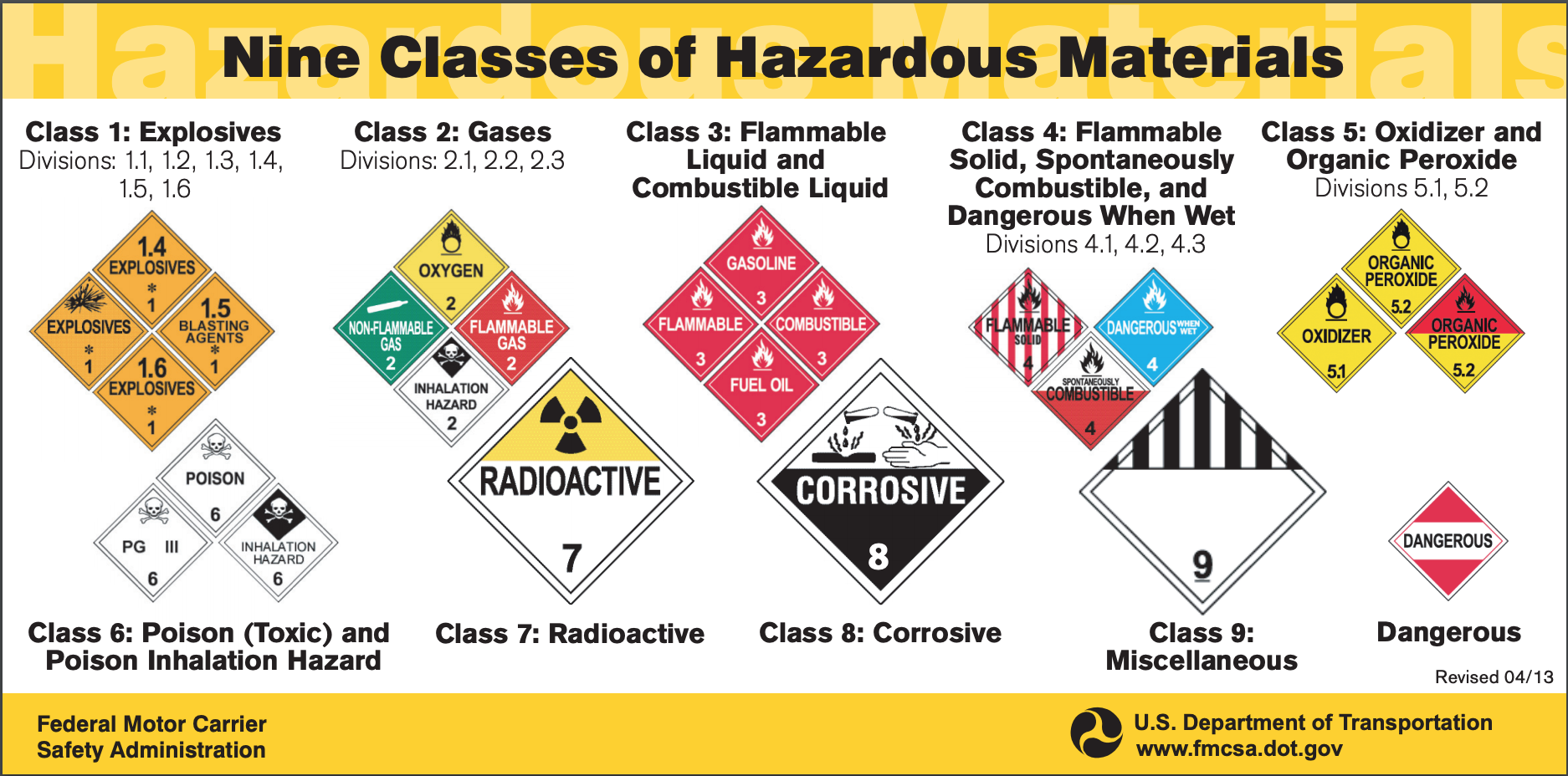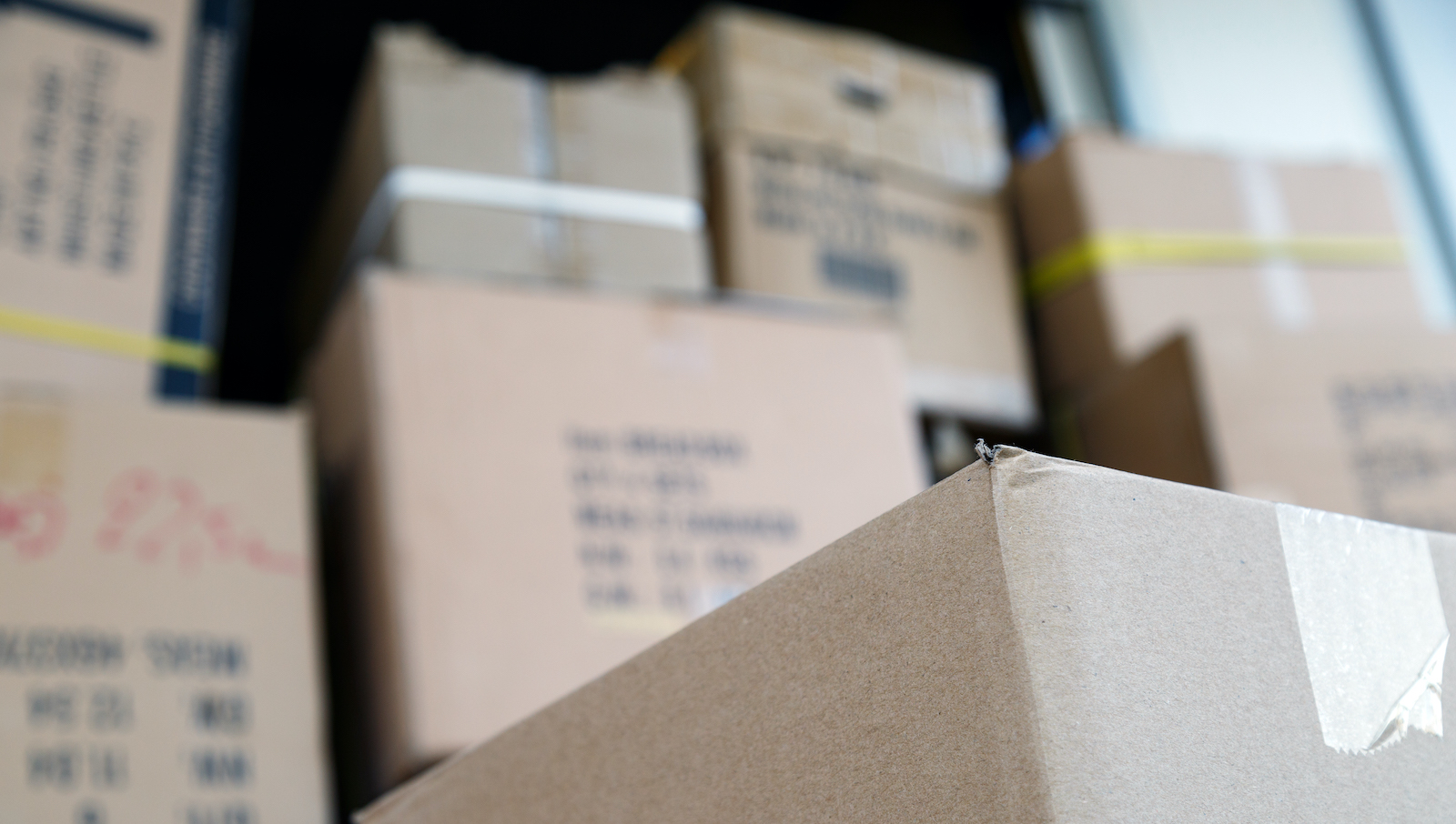Table of Contents
** Minutes
What products are classified as HAZMAT?
How to ship hazardous materials
Regulations for HAZMAT shipping
Penalties for noncompliance when shipping hazardous materials
What do you want to learn?
Paint. Nail polish. Dry shampoo. Hair spray. Perfume. Batteries. E-cigarettes.
While these may seem like everyday items for some people, did you know they are considered dangerous goods? If you sell these products online, you will face some challenges shipping them.
You may think ‘hazardous’ or ‘dangerous’ products are items like nuclear waste and other highly toxic chemicals, but they actually encompass much more ordinary items. Why? Because those who handle or store these products (e.g., in a warehouse or on a truck, plane, or ship) may be injured if the product drops, breaks, spills, or comes in contact with another substance.
Hazardous materials (HAZMAT) are among the most complicated, regulation-heavy, and expensive products to ship. Because they could pose a danger to people, property, or the environment, there are many rules and regulations required to transport them.
The US Department of Transportation (US DOT) requires that you be trained and certified before you ship hazardous materials. The requirements cover packaging and labelling of hazardous materials as well as the proper documentation. There are also fines for non-compliance and potential legal action if you are found to have willfully ignored hazardous materials shipping regulations.
In this guide, we’ll cover which HAZMAT class various products are, how you can ship them legally, the regulations and requirements you need to sell and distribute hazardous materials, and more.
What are hazardous materials?
Hazardous materials (or dangerous goods) are solids, liquids, or gases that can harm people, other living organisms, property, or the environment if improperly shipped, stored, or handled.
What products are classified as HAZMAT?
HAZMAT products are broken into nine classes, ranging from the most extreme materials like explosives, gases, toxic materials, and radioactive materials to more seemingly minor products like hair spray, liquor, and nail polish that still pose a shipping and handling risk. Each of these classes has a specific sub class that also provides more details on the classification.

Source: Federal Motor Carrier Safety Administration.
Class 1: Explosives
As the name implies, these are products likely to explode under certain conditions.
- Division 1.1: Explosives with a mass explosion hazard
- Division 1.2: Explosives with a projection hazard
- Division 1.3: Explosives with predominantly a fire hazard
- Division 1.4: Explosives with no significant blast hazard
- Division 1.5: Very insensitive explosives
- Division 1.6: Extremely insensitive explosive articles
Examples of Class 1 HAZMAT products include ammunition, gun powder, fireworks, airbag inflators, and seat belt pretensioners.
Class 2: Gases
These are products that contain gases that are dangerous when inhaled or when they make contact with a surface.
- Division 2.1: Flammable gases
- Division 2.2: Non-flammable gases
- Division 2.3: Poison gases
- Division 2.4: Corrosive gases
Examples of Class 2 HAZMAT products include aerosols (spray paint, household cleaners, bathroom sprays, and spray cosmetics such as hair care products, deodorants, and perfumes), propane tanks, lighters, pepper spray, scuba tanks, self-inflating rafts, and fire extinguishers.
Class 3: Flammable liquids
These are liquids that will ignite when making contact with fire.
- Division 3.1: Flashpoint below -18°C (0°F)
- Division 3.2: Flashpoint below -18°C and above, but less than 23°C (73°F)
- Division 3.3: Flashpoint 23°C and up to 61°C (141°F)
Examples of Class 3 HAZMAT products include gasoline, nail polish, lighter refills, oil-based paints, paint thinner, and varnish.
Class 4: Flammable solids
Products that will ignite when making contact with fire fall into this category.
- Division 4.1: Flammable solids
- Division 4.2: Spontaneously combustible materials
- Division 4.3: Materials that are dangerous when wet
Examples of Class 4 HAZMAT products include matches, sulfur, coal, fish oil, potassium, sodium, and sodium batteries.
Class 5: Oxidizers/organic peroxides
These are chemicals that readily yield oxygen in reactions, thereby causing or enhancing combustion.
- Division 5.1: Oxidizers
- Division 5.2: Organic peroxides
Examples of Class 5 HAZMAT products include ammonium nitrate fertilizers, bleach, hydrogen peroxide, chlorine, and sodium nitrate.
Class 6: Toxic and infectious substances
In this class are substances that can cause death, serious injury, or harm to humans if inhaled or swallowed. Infectious substances are known to carry pathogens (bacteria, viruses, fungi, etc.).
- Division 6.1: Poisonous materials
- Division 6.2: Etiologic (infectious) materials
Examples of Class 6 HAZMAT products include biomedical waste (e.g., blood samples and used needles), arsenic, pesticides, and nicotine.
Class 7: Radioactive material
This is any material or combination of materials that spontaneously gives off ionizing radiation. It has a specific activity greater than 0.002 microcuries per gram.
Examples of Class 7 HAZMAT products include medical isotopes, radioactive medicines, isotopes used in research (Carbon-14, etc.), X-ray machines, and depleted uranium.
Class 8: Corrosives
A corrosive is a material, liquid, or solid that causes visible destruction or irreversible alteration to human skin or a liquid that has a severe corrosion rate on steel or aluminum.
Examples of Class 8 HAZMAT products include sulfuric acid, hydrochloric acid, sodium hydroxide, wet and NiCad batteries, drain cleaner, paint and paint stripper, and mercury thermometers and barometers.
Class 9: Miscellaneous hazardous materials
Products in this class include materials that present a hazard during transport but are not included in another hazardous freight classification.
Examples of Class 9 HAZMAT products include dry ice, lithium-ion batteries, vehicles, and first-aid kits.
Read more from the Federal Aviation Administration (FAA): Commonly Shipped Undeclared Hazardous Materials.
How to ship hazardous materials
Shipping hazardous materials can be a complicated process, as there are serious implications for getting it wrong. In order to ship hazardous materials, you need to follow a few key steps.
Classify the material
When shipping HAZMAT, a product safety data sheet (SDS) is required by law to be provided to whoever is handling the dangerous materials. The SDS provides guidance to help workers who handle these products become familiar with the materials and also prevent mishandling them.
Contact top couriers
The top couriers in the US (FedEx, USPS, UPS, and DHL) all provide shipping options for hazardous materials. Each carrier has specific rules about how they work with you for handling HAZMAT (more on that below).
Select appropriate packaging
Depending on the type of product, there are specific laws for how you package HAZMAT products. For example, dangerous liquids are best suited for drums, but they can be stored in steel, aluminum, or plastic drums depending on the type of liquid.
Mark and label your package
There are specific ways to mark your hazardous materials depending on their class, ID number, weight, and more. Be sure to follow the correct regulations when it comes to marking, labelling, and placarding. Even the orientation of your arrows can prevent a product from being shipped.

Source: US Department of Transportation.
Prepare shipping papers
Some couriers require additional paperwork in order to ship HAZMAT items depending on the material to be transported (e.g., the UN identification number, proper shipping name, hazard class, and packing group, as well as the quantity, number, and type of packages, emergency contact information, and shipper’s certification). You must prepare all requested documents to ensure your shipment goes out and is not delayed or held up.
Identify additional carrier requirements
Most couriers have pretty similar rules when it comes to shipping HAZMAT. However, a few of them also have additional requirements. Depending on the carrier you work with, ask them about all of the HAZMAT shipping requirements before you start shipping dangerous goods.
Regulations for HAZMAT shipping
Here are the regulations you’ll want to know about if you’re selling a product that contains hazardous materials.
49 CFR (Code of Federal Regulations, Title 49)
Title 49 of the Code of Federal Regulations addresses key protocols for preparing, shipping, and handling dangerous goods. It is issued by the Departments of Transportation and Homeland Security. Access it here.
IMDG Code
The International Maritime Dangerous Goods Code (IMDG) provides guidelines for the safe shipment of goods on water or vessel. It is accepted as an international guideline, and it is mainly used in international shipping.
ICAO / IATA
The International Civil Aviation Organisation (ICAO) standardizes safety procedures for shipping dangerous goods by air. The International Air Transport Association (IATA) also has its own Dangerous Goods Regulations (DGR) to help you prepare, handle or accept dangerous goods shipments by air.
Penalties for noncompliance when shipping hazardous materials
As with all shipping regulations, noncompliance for hazardous material shipping can cost you greatly. The US DOT has specific fines for companies that break these laws. A routine shipment with even the tiniest error can lead to six-figure fines and have you banned from shipping HAZMAT products.
As federal law states, under 49 CFR Part § 107.329, “A person who knowingly violates a requirement of the Federal hazardous material transportation law, an order issued thereunder, this subchapter, subchapter C of the chapter, or a special permit or approval issued under this subchapter applicable to the transportation of hazardous materials or the causing of them to be transported or shipped is liable for a civil penalty of not more than $77,114 for each violation, except the maximum civil penalty is $179,933 if the violation results in death, serious illness or severe injury to any person or substantial destruction of property. There is no minimum civil penalty, except for a minimum civil penalty of $463 for violations relating to training. When the violation is a continuing one, each day of the violation constitutes a separate offense.”
4 couriers that ship hazardous materials
The four major couriers in the US (FedEx, USPS, UPS, and DHL) all offer shipping for hazardous materials. Each carrier has specific rules for how they ship dangerous goods for certain classes, as well as shipping HAZMAT domestically and internationally by truck, air, and sea.
1. FedEx
FedEx provides training and a guide on how to ship hazardous materials, including how to become approved to ship hazardous materials, information on battery shipments, services and restrictions, accepted and prohibited materials, marking and labelling, packaging, and more. Read the FedEx hazardous materials guide.
2. USPS
USPS ships HAZMAT products, though there are restrictions for domestic and international HAZMAT shipments. You cannot ship items like matches, aerosols, tobacco products, glues, perishable items, and much more through any USPS mail type. Contact your local post office to learn if they can help you. Read their list of mailable and prohibited products here.
3. DHL
DHL is an established carrier of dangerous goods and adheres to the IATA and ADR regulations as well as other applicable national legislation. See DHL’s guide to shipping dangerous goods to view conditions to ship, dangerous goods charges, summary of the shipper’s responsibility, other important facts and information, and to contact a DHL HAZMAT expert.
4. UPS
UPS ships hazardous materials and provides training for those new to shipping these materials. The UPS Guide for Transporting Hazardous Materials includes updated regulatory information, UPS hazardous material requirements, examples of the proper use of box markings, and more information for safely and successfully transporting hazardous materials.
Find which classes UPS can ship here. If you have any questions about shipping hazardous materials with UPS, you can call the UPS Hazardous Materials Support Centre at 1-800-554-9964.
HAZMAT shipping and ShipBob
ShipBob is a third-party logistics (3PL) company that helps ecommerce businesses store inventory, pick and pack products, and ship orders, working with all four couriers mentioned above. ShipBob can work with some brands that sell dangerous goods and ship orders domestically via ground, though there are some limitations.
“Touchland sells flammable goods that need to be shipped via ground, so ShipBob has been a great ally as they have fulfilment centres all over the US, facilitating a 2-3 day delivery time for any customer in the US.”
Andrea Lisbona, Founder & CEO of Touchland
ShipBob complies with regulations
At ShipBob, we pride ourselves on meeting regulatory requirements. Our warehouses are certified to meet local, state, and federal laws for dangerous materials, and our workers are trained on 49 CFR and know how to handle dangerous goods.
For every dangerous good that ShipBob ships (e.g., lithium-ion batteries, aerosols, hand sanitisers that contain less than 80% alcohol content, and others), the shipping label denotes that it is a dangerous good, so couriers know what’s inside. ShipBob will not ship HAZMAT items internationally, expedited, or via air transport.
Instructions for shipping hazardous materials with ShipBob
For products approved by ShipBob, merchants must mark each SKU as a ‘Dangerous Good’ in ShipBob’s dashboard in order to comply with all regulations. Follow these instructions to do so:
- Navigate to ‘Inventory’ and then click ‘Products.’
- Click the product ID number you would like to mark as a dangerous good.
- From the ‘Product Details’ page, scroll down to ‘Fulfilment Information’ panel. Mark the checkbox stating: ‘This is classified as dangerous goods.’
- Once you mark the product as a dangerous good, you will need to upload its MSDS (material safety data sheet) file. Click ‘Upload New MSDS’ and attach the file.
Note: International orders containing HAZMAT products will not be fulfiled by ShipBob. If a HAZMAT order is attempted to be shipped this way, it will be put on hold.
“We download Excel files from the ShipBob dashboard all the time and use them to analyse everything from cancelations, to examining order weights, to checking on whether ShipBob is shipping orders on time. Even the way their warehouse receiving orders (WROs) work for sending inventory is very straightforward.”
Ines Guien, Vice President of Operations at Dossier
Conclusion
Shipping hazardous materials can be a complex and expensive process. Because there are so many rules and regulations required, make sure you have all the right paperwork and research completed before you attempt shipping.
You can also work with a 3PL that handles order fulfilment for hazardous materials. Learn if ShipBob can help your brand ship HAZMAT products in a safe manner. Contact our team below to learn more.
Shipping hazardous materials FAQs
Yes, many of the major couriers have services that provide the shipping of hazardous materials, including UPS. However, it is not as simple as dropping it in the mailbox. There are procedures and processes involved and each is carrier-specific.
This usually depends on context. According to the Federal Aviation Administration (FAA), HAZMAT and dangerous goods are the same things. But this is from an aviation standpoint, obviously. According to the Australian state of Victoria’s occupational health and safety unit, the difference between a hazardous material and a dangerous good is that a dangerous good has the risk of immediate danger, whereas a hazardous material may have long-term health effects.
There are quite a few hazardous materials that could require shipping. There are actually 9 categories that hazardous materials fall into. Explosives, gasses, flammable liquids and solids, and toxic and infectious substances are all examples of hazardous materials. Some examples of these include motor oil, household cleaning supplies, propane, paint, and pesticides, just to name a few.



